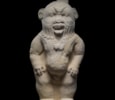Statue of Bes
Statue of Bes
Large Statue of Bes
Circa 664-30 B.C., Late Period-Ptolemaic Period, Egypt
Limestone
H: 50 cm, W: 24 cm
Sold
A large freestanding statue of the ancient Egyptian god Bes in his canonical form as a stocky dwarf. His face is highly expressive, with large, teardrop-shaped eyebrows drawn into an exaggerated frown over the small, deep-set eyes. Large round ears protrude on either side of the head. Below the broad nose, the tongue extends from the wide-open mouth. A long, curled beard hangs on either side of the head, obscuring the neck completely. He wears an animal skin over his shoulders and a blet around his waist, but is otherwise nude. His hands rest on his hips, and his broad legs appear slightly bowed, as is typical for images of Bes. A long tail extends from the pronounced buttocks at the rear, down to the base of the statue.
Bes was worshipped as a protector of households, especially mothers and children. With his wild beard, lion’s mask, and loud instruments, Bes was believed to ward off evil spirits. He was thus seen as a protector of women during labour, alongside the goddess Taweret. Later he became the defender of all that is good, and the god of music and merriment. Unlike other Egyptian deities, images of Bes were kept within the home as apotropaic devices. He was depicted in full face portrait, rather than in profile, even when in relief. Worship of Bes spread as far north of Syria and as far west as the Balearic Islands in Spain, and continued into the Roman and Achaemenid Empires.
Égypte-France, Musée des Arts Décoratifs, Pavillon de Marsan, Paris, October-November 1949, no. 69.
Galerie d’Eendt, Amsterdam, 22 May-15 July 1967, no. 79.
Égypte-France, Musée des Arts Décoratifs, Pavillon de Marsan, Paris, October-November 1949, exhibition catalogue, no. 69.
Previously with Ernst Ascher (1888-1978), 1, rue des Beaux Arts, Paris, by at least 1949, accompanied by handwritten consignment note to the Égypte-France exhibition.
Private Collection of W. Hoogstrate, the Netherlands, acquired from the above, circa 1960-1964.
Thence by descent.
1949 Ascher consignment document.
ALR: S00261299, with IADAA Certificate, this item has been checked against the Interpol database.
Ernst Ascher (1888-1978) was a painter and art dealer, most known for dealing in African and Oceanic art. Born in Prague, Ascher was a member of the ‘Prague Circle’ of German-speaking writers, alongside Paul Leppin, Max Brod, and Emil Faktor. He studied painting in Munich, and moved to France in around 1910, where he lived between Paris and the small southern town of Céret. After the First World War, Ascher moved into a studio in the Montparnasse district. He soon transitioned from his work as a painter to that of an art dealer, having been initiated into the trade by Joseph Brummer, of the Brummer Galleries. Ascher made a living by selling paintings, antiques, and African and Oceanic artworks. Between 1928 and 1930, he opened a gallery at 133 Boulevard du Montparnasse, which exhibited modern artists, including his close friend Picasso. He was good friends with many of the artists, dealers, and thinkers in Paris at the time, including Charles Ratton, Albert Einstein, Josef Müller, André Derain, and Pierre Lévy. Through Ascher’s contacts, his cousin Zika Ascher and his wife Lida, founded a textile business that created original fabrics designed by leading artists of the period. In 1933, Ascher and Ratton were hired by Swiss Volksbank to appraise the first African art collection of Han Coray (1880-1974), which was dispersed in 1940 to various European museums. Ascher’s main suppliers included Alfred Flechtheim, Hans Purrman, Jean Roudillon, and Arthur Speyer II. He also bought widely at auction, and bought pieces from at least fifteen sales between 1927 and 1937.
In 1930, Ascher moved to 16 Rue Jacques Callot, and opened a gallery nearby at 1 Rue des Beaux-arts. In the thirties, he traded with Galerie Pierre Matisse in New York, bridging into the American market. The gallery closed during the Second World War, and Ascher went into refuge in Normandy. He served as a translator for the Czech resistance and for the Americans following the liberation. He returned to his gallery after the war and continued to run it until the end of his life. Works that passed through his hands can now be found in many prestigious museums, including the Metropolitan Museum of Art, New York, the Barbier-Müller Museum, Geneva, the Musée du Quai Branly, Paris, the Brooklyn Museum, the Musée du Louvre, Rietberg Museum, Zurich, Musée des Beaux-Arts of Montreal, Sainsbury Centre, Norwich, Fondation Gandurm Geneva, and the Barnes Foundation of Philadelphia.










 Enquire
Enquire




